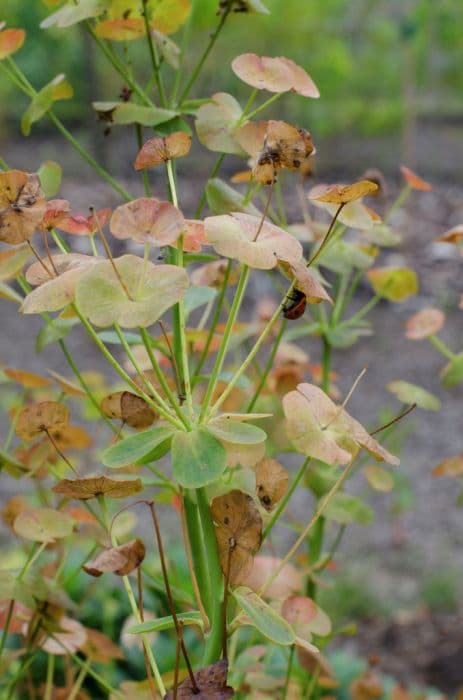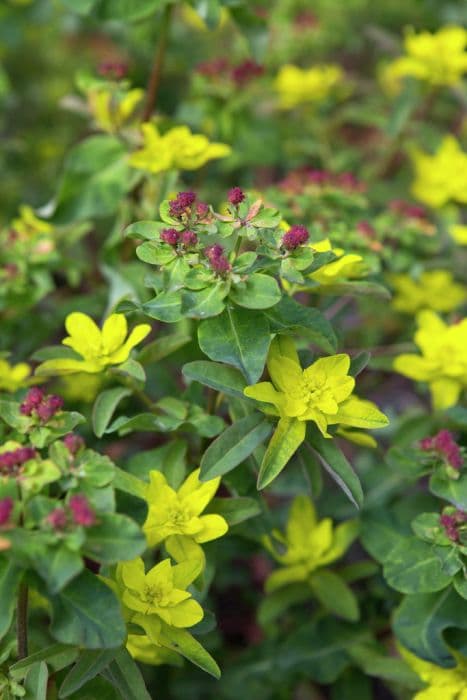Martin's Spurge Euphorbia × martini 'Walberton's Red Flush'

ABOUT
Euphorbia × martini 'Walberton's Red Flush', commonly known as Martin's spurge, displays a stunning visual appeal that draws gardeners and plant enthusiasts alike. This vibrant plant bears an impressive foliage that shifts in color with the seasons. During the cooler months, the leaves exhibit a striking reddish-pink tinge, which transitions to a fresh green with warmer weather. The foliage is densely arranged in a rosette-like pattern, emanating from the central stems to create a lush and compact appearance. Complementing its attractive leaves, Martin's spurge produces distinctive flower-like structures referred to as cyathia, which are the main feature of many plants in the Euphorbia family. These cyathia consist of a central cup brimming with nectar, encircled by showy, colorful modified leaves called bracts. In the case of 'Walberton's Red Flush', these bracts are a vivid yellow with a red center, closely resembling petite flowers. They bloom in the springtime and add a bright splash of color to the plant. The overall aesthetic of the Martin's spurge is one of year-round beauty, with the foliage providing a backdrop of color variations through the seasons and the blooms bringing a touch of cheer in the spring. It is a popular choice for gardeners who seek an ornamental plant with a long-lasting display of color and texture.
About this plant
 Names
NamesFamily
Euphorbiaceae
Synonyms
Martin's Spurge, Red Martin Spurge
Common names
Euphorbia × martini 'Walberton's Red Flush'.
 Toxicity
ToxicityTo humans
The Martin's spurge is considered toxic to humans due to the latex-like sap contained within its stems and leaves. This sap can cause skin irritation upon contact, including redness, swelling, and blistering. If ingested, the sap of Martin's spurge can irritate the mouth, throat, and stomach, leading to symptoms such as nausea, vomiting, and diarrhea. In severe cases, ingestion might cause more serious systemic effects, though this is relatively rare. As a precaution, always wear gloves when handling the plant and avoid touching your face or eyes.
To pets
Martin's spurge is also toxic to pets, as the sap contains irritants that can cause similar reactions as seen in humans. If a pet chews on or ingests parts of the plant, symptoms may include drooling, vomiting, diarrhea, and rarely more severe symptoms such as difficulty breathing or swallowing. Contact with the skin can lead to dermatitis, and if the sap gets into the eyes, it can cause pain and temporary vision problems. Therefore, it is important to keep Martin's spurge out of reach of pets and seek veterinary care if you suspect your pet has ingested this plant.
 Characteristics
CharacteristicsLife cycle
Perennials
Foliage type
Evergreen
Color of leaves
Green
Flower color
Red
Height
2 feet (60 cm)
Spread
2 feet (60 cm)
Plant type
Shrub
Hardiness zones
7
Native area
Hybrid
Benefits
 General Benefits
General Benefits- Low Maintenance: Martin's Spurge 'Walberton's Red Flush' does not require frequent watering or care once established, making it ideal for gardeners of all levels.
- Drought Tolerant: This plant is well-suited to dry conditions, requiring minimal supplemental water after establishment.
- Year-Round Interest: The plant features evergreen foliage and vibrant bracts that provide visual interest throughout the year.
- Attracts Wildlife: The colorful bracts and nectar-rich flowers can attract pollinators such as butterflies and bees to the garden.
- Deer Resistant: Martin's Spurge 'Walberton's Red Flush' is not favored by deer, reducing the likelihood of damage from grazing.
- Versatile Placement: Suitable for planting in beds, borders, and containers, adding flexibility in garden design.
- Ground Cover: Owing to its spreading habit, it can act as an effective ground cover, suppressing weeds and covering bare spots.
- Foliage Contrast: It provides excellent foliage contrast in the garden with its dark green leaves flushed red.
- Easy Propagation: Can be easily propagated from cuttings, allowing gardeners to expand their plantings with little additional cost.
- Cold Hardy: This hybrid euphorbia can tolerate low temperatures, making it suitable for a variety of climates.
 Medical Properties
Medical PropertiesThis plant is not used for medical purposes.
 Air-purifying Qualities
Air-purifying QualitiesThis plant is not specifically known for air purifying qualities.
 Other Uses
Other Uses- Floral Arrangements: The Euphorbia × martini 'Walberton's Red Flush' can be used as a striking foliage contrast in floral arrangements, with its deep red tips and green body providing a unique touch to bouquets and centerpieces.
- Photography Subject: Photographers may take an interest in 'Red Martin' spurge for its unique coloration and structure, making it an interesting subject for botanical and garden photography.
- Educational Tool: This plant can serve as a resource for botany and horticulture students to study hybridization and plant adaptation, due to its cross-genus origins.
- Culinary Garnish: Although not edible, the vibrant foliage of the 'Red Martin' spurge can be used as a decorative, non-toxic garnish for plating in high-end culinary presentations.
- Natural Dye: The colorful sap of Euphorbia × martini 'Walberton's Red Flush' might be explored as a natural dye for fabrics, although it must be handled carefully due to its potential skin irritating properties.
- Living Sculptures: Garden designers can use this architectural plant to create living sculptures in gardens or as part of green installations in public spaces.
- Garden Photography Props: 'Red Martin' spurge can be used in garden magazines or promotions as props to add color and depth to garden scenes.
- Seasonal Festivities: The red and green color scheme of 'Red Martin' spurge makes it a pleasing addition to garden displays for Christmas and other festive holiday decorations.
- Landscape Contrast: This euphorbia can be planted in rocky or Mediterranean landscapes to provide aesthetic contrast with its sharp foliage against soft-textured plants like lavender or ornamental grasses.
- Environmental Art: Artists can incorporate 'Red Martin' spurge into environmental art pieces, using its form and color to create outdoor installations that interact with the natural landscape.
Interesting Facts
 Feng Shui
Feng ShuiThe Spurge is not used in Feng Shui practice.
 Zodiac Sign Compitability
Zodiac Sign CompitabilityThe Spurge is not used in astrology practice.
 Plant Symbolism
Plant Symbolism- Resilience: Euphorbias are known for their hardy nature, able to withstand harsh conditions. 'Walberton's Red Flush', as a type of Spurge, symbolizes an individual's ability to endure and thrive through difficult times.
- Protection: Many Euphorbia species exude a milky sap when cut that can be irritating to the skin and mucous membranes; thus, Spurge can represent protection and the ability to repel harm or negative forces.
- Purification: Historically, Spurge was used in traditional medicine to cleanse the body, symbolizing purification, cleansing from bad influences or negative thoughts.
 Water
WaterFor Spurge 'Walberton's Red Flush', it's important to water deeply but infrequently, allowing the soil to dry out between waterings to avoid overwatering. Water with approximately 1 gallon per plant every 7 to 10 days during the growing season, and reduce watering in the winter. It's best to water the plant at the base, avoiding wetting the foliage. Overhead watering should be avoided to minimize the risk of disease.
 Light
LightSpurge 'Walberton's Red Flush' thrives best in full sun to partial shade conditions. It is adaptable but prefers a spot that receives at least six hours of sunlight daily. However, in extremely hot climates, providing some afternoon shade will help protect the plant from excessive heat.
 Temperature
TemperatureSpurge 'Walberton's Red Flush' prefers a temperature range between 50°F and 75°F but can tolerate temperatures as low as 30°F for short periods. It's important to protect the plant from frost, which can damage the foliage and stems. The ideal growing conditions for this plant would be in a temperate climate with consistent warmth during its growing season.
 Pruning
PruningSpurge 'Walberton's Red Flush' should be pruned to remove any damaged or diseased foliage and to maintain its shape. This is best done after flowering, typically in late summer or early fall. Cutting back the plant by one-third every few years encourages healthy new growth. Pruning can also be used to control the size and spread of the plant if necessary.
 Cleaning
CleaningAs needed
 Soil
SoilMartin's Spurge prefers a well-draining soil mix, with a combination of loam, sand, and compost to ensure proper drainage and aeration. A soil pH around 6.0 to 7.5 is ideal for this plant. Regular garden soil can be amended with perlite or coarse sand to improve drainage.
 Repotting
RepottingMartin's Spurge typically needs repotting every two to three years as it grows. This is usually done in the spring, to give the plant a fresh start in the growing season. It is important not to over-pot; choose a pot that is just one size larger.
 Humidity & Misting
Humidity & MistingMartin's Spurge thrives in average room humidity levels. It is relatively drought-tolerant and does not require high humidity. Ensuring good air circulation around the plant will help maintain the appropriate humidity levels.
 Suitable locations
Suitable locationsIndoor
Place in bright indirect light, away from cold drafts.
Outdoor
Give full sun to partial shade and protect from harsh winds.
Hardiness zone
6-9 USDA
 Life cycle
Life cycleEuphorbia × martini 'Walberton's Red Flush', commonly known as Martin's spurge, begins its life cycle as a seed, which after germination, develops into a seedling. The seedling grows into a vegetative plant, establishing a strong root system and foliage. As the plant matures, it enters the flowering stage, characterized by the production of small flowers surrounded by red-flushed bracts, typically in the spring. Following pollination, seeds are produced and dispersed, completing the reproductive cycle. The plant may also propagate vegetatively through division, where parts of the root system are separated to grow new plants. Being a perennial, Martin's spurge will enter a period of dormancy during the cold months, reducing growth, to resume its cycle in the following spring.
 Propogation
PropogationPropogation time
Early summer
Euphorbia × martini 'Walberton's Red Flush', also known by its common name Martin's spurge, is typically propagated by taking cuttings. The most popular method is to take semi-ripe cuttings in late summer, which involves selecting a healthy, non-flowering stem and cutting a 3 to 4 inch (approximately 7.5 to 10 cm) portion just below a node. It’s vital to let the cut end callous over for a few hours to reduce the risk of sap irritation and to prevent rot. Once calloused, the cutting can be dipped in rooting hormone powder and placed into a well-draining potting mix. Cover the potted cutting with a plastic bag or place in a propagator to maintain humidity and then locate it in a warm area with indirect light. Roots typically develop within a few weeks, after which you can gradually acclimate the new plant to less humid conditions before eventually potting it up. It's important to handle the plant carefully as the sap can be an irritant to skin and eyes.


![Spurge [Silver Swan]](/_next/image?url=https%3A%2F%2Fplants-admin.emdemapps.com%2Fimages%2Fplants%2F%2Fimages%2F604b573f6c8f6.png&w=640&q=75)






